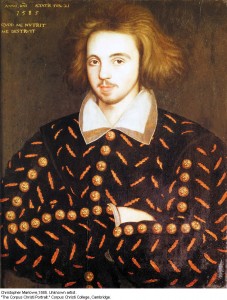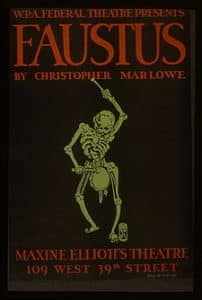Christopher Marlowe contributed greatly to English literature. He developed a new meter which has become one of the most popular in English literary history, and he revitalized a dying form of English drama. His short life was apparently violent and the man himself was supposedly of a volatile temperament, yet he managed to write some of the most delicate and beautiful works on record. His writing is representative of the spirit of the Elizabethan literature in his attitude towards religion, his choice of writing style and in the meter that he used.
Christopher Marlowe was born in 1564 the son of a Canterbury shoemaker and was an exact contemporary of Shakespeare. He was  educated at the King’s School, Canterbury, and Corpus Christi College, Cambridge. He became a BA in 1584 and a MA in 1587. He seems to have been of a violent nature and was often in trouble with the law. He made many trips to the continent during his short lifetime and it has been suggested that these visits were related to espionage. In 1589 he was involved in a street brawl which resulted in a man’s death. An injunction was brought against him three years later by the constable of Shoreditch in relation to that death. In 1592 he was deported from the Netherlands after attempting to issue forged gold coins. On the 30th of May 1593 he was killed by Ingram Frizer in a Deptford tavern after a quarrel over the bill. He was only 29 years old. During the middle ages, culture and government were influenced greatly by the Church of Rome. The Reformation of Henry VIII (1529-39), and the break of ties with that church meant that the monarch was now supreme governor.
educated at the King’s School, Canterbury, and Corpus Christi College, Cambridge. He became a BA in 1584 and a MA in 1587. He seems to have been of a violent nature and was often in trouble with the law. He made many trips to the continent during his short lifetime and it has been suggested that these visits were related to espionage. In 1589 he was involved in a street brawl which resulted in a man’s death. An injunction was brought against him three years later by the constable of Shoreditch in relation to that death. In 1592 he was deported from the Netherlands after attempting to issue forged gold coins. On the 30th of May 1593 he was killed by Ingram Frizer in a Deptford tavern after a quarrel over the bill. He was only 29 years old. During the middle ages, culture and government were influenced greatly by the Church of Rome. The Reformation of Henry VIII (1529-39), and the break of ties with that church meant that the monarch was now supreme governor.
This altered the whole balance of political and religious life, and, consequently, was the balance of literature, art and thought. The literature of Elizabethan England was based on the crown. This period of literature (1558-1625) is outstanding because of its range of interests and vitality of language. Drama was the chief form of Elizabethan art because there was an influx of writers trying to emulate speech in their writing, and because of the suddenly expanded vocabulary writers were using (most of these new words came from foreign languages).
Marlowe’s plays comprise The Tragedy of Dido, Queen of Carthage (possibly with some collaboration from Nashe), Tamburlaine parts one  and two, The Jew of Malta, Edward II, Dr. Faustus and The Massacre at Paris. Up to the time of Tamburlaine, written in 15 87-8, there had been a few so-called tragedies. Of these, the best known is Gorboduc, first played in 1561, and apparently popular enough to justify its printing a few years later, although the play was “a lifeless performance, with no character of enough vitality to stand out from the ruck of the rest of the pasteboards.” With Tamburlaine, Marlowe swept the Elizabethan audiences off their feet. The Jew of Malta, written after Tamburlaine, begins very strongly, with the main character a commanding figure of the same caliber as Tamburlaine, and the characterization is better rounded than Tamburlaine’s. Sadly the play comes to pieces after the second act, and it has been speculated that another less talented author revised the ending. Edward II is unexpected in that the main character is a neurotic weakling, instead of a dominant figure like Henry V. Even though the characterization is clumsy, it is yet a dramatist’s treatment, and one can see that Marlowe has moved towards creating a more developed character.
and two, The Jew of Malta, Edward II, Dr. Faustus and The Massacre at Paris. Up to the time of Tamburlaine, written in 15 87-8, there had been a few so-called tragedies. Of these, the best known is Gorboduc, first played in 1561, and apparently popular enough to justify its printing a few years later, although the play was “a lifeless performance, with no character of enough vitality to stand out from the ruck of the rest of the pasteboards.” With Tamburlaine, Marlowe swept the Elizabethan audiences off their feet. The Jew of Malta, written after Tamburlaine, begins very strongly, with the main character a commanding figure of the same caliber as Tamburlaine, and the characterization is better rounded than Tamburlaine’s. Sadly the play comes to pieces after the second act, and it has been speculated that another less talented author revised the ending. Edward II is unexpected in that the main character is a neurotic weakling, instead of a dominant figure like Henry V. Even though the characterization is clumsy, it is yet a dramatist’s treatment, and one can see that Marlowe has moved towards creating a more developed character.
Marlowe thus breathed new life into English tragedy, and paved the way for the greatest English dramatist, Shakespeare. It is quite possible that without Marlowe’s contribution to English tragedy, Shakespeare would never have at tempted such an unpopular style and he would not be canonized as he is today. The Tragical History of Doctor Faustus is surely the pinnacle of Marlowe’s achievement. The subject no doubt appealed to Marlowe. In no other play of his, nor in the majority of English literature, is there a scene to match the passionate and tragic intensity of Faustus’ last hour on earth. Faustus used to be placed as the play immediately following Tamburlaine, yet a discovery by Dr. F. S. Boas led to the conclusion that the play cannot be dated before 1592. This was because the English translation of the German Faustbuch was not published until 1592, and though it is possible that Marlowe saw the manuscript before publication, the evidence suggests that Dr. Faustus was written after Edward II. This would mean that instead of making a massive jump in quality from Tamburlaine and The Jew of Malta to Dr. Faustus, and then reverting back to Edward II, Marlowe wrote Tamburlaine and The Jew and felt that he had not really set his genius and so casts back to the type of these earlier plays and far surpasses them in dramatic poetry. Faustus tells of a man who sells his soul to Satan in return for twenty-four years of knowledge and power.
The protagonist, Dr. John Faustus, instead of sharing his gift with others, fritters his years away until the in last scene he realizes the grave mistakes he has made. The scenes where Faustus uses his power for practical jokes are in stark contrast to those where something meaningful happens to him. There are three places in the play where Marlowe’s genius can be seen illuminated by perfection of meter and rhetoric; the scene where Faustus conjures up Mephistopheles, the scene in which he speaks to Helen of Troy and Faustus’ last hour on Earth. It has been suggested by some that Marlowe only wrote these three scenes and the rest was added by someone else. However these are probably the same people who think Marlowe and Shakespeare are the same man. Even so, these scenes were unmatched in their word play and meter until Shakespeare. This play is timeless because its subject matter is still interesting today and because the force of Marlowe’s conviction cannot help but invoke emotions in even the most soulless of critics.
Possibly Marlowe’s greatest gift to English literature was his metre. Marlowe was the real creator of the most famous, most versatile and noblest of English measure, the unrhymed decasyllabic (ten syllables) line called blank verse. Blank verse or iambic pentameter as it is known was first used twenty or so years before Marlowe, however it was intolerably monotonous. The metre comes from the Greek Iambic trimeter, which was a twelve- syllable line with six feet. The experimenters were perceptive enough to see that the more slowly moving English language would require five feet instead of six. Marlowe’s writing is reflective of the spirit of the Elizabethan age in a number of ways. His subject matter and characters in his plays often question the validity of the church.
He has been criticised for being an atheist, for example he was accused of blasphemy in his portrayal of Helen in Dr. Faustus She is seen as a goddess who has the power to cleanse Faustus’ soul, even though God cannot. She is more powerful than the virgin Mary, and the fact that Marlowe presents the proposition that God is incapable of redeeming Faustus’ soul farther aggravated the church. This new thinking about the church is part of the spirit of the Elizabethan age due to King Henry VIII’s reformation. In many Elizabethan plays, the main character is a merchant of some sort, due to the rise in power of these middle class businessmen.
This can be seen in many plays of Shakespeare, as well as Marlowe’s The Rich Jew of Malta. Also the protagonists in Marlowe’s plays are often similar to Everyman, particularly Dr. Faustus, except that these characters are individuals, and not mankind in general, in that the character learns something which is important to the audience as well. The Everyman plays were written shortly before Marlowe’s birth, and again this re- characterisation by Marlowe is a reflection of the spirit of the times in his works. Lastly, the fact that Marlowe used iambic pentameter, as well as having drama as his writing style is representative of the Elizabethan age.
Although these were contributions to English literature, Marlowe really set the trend for this age, and many contemporaries of his used these techniques. In that sense, one of Marlowe’s contributions to English literature was that he defined a lot of the aspects of Elizabethan literature. Marlowe’s revolutionary use of literature is both representative of the age, as well as a contribution to English literature. Marlowe contributed greatly to English literature.
His works are excellent on their own; though he also revitalised the tragedy as well as developing blank verse, one of the most beautiful, flexible and versatile of metres. His work is representative of the spirit of the Elizabethan age in that Marlowe used drama as his chief form of writing, his subject matters were demonstrative of this age, for example the loss of belief in the church, and he wrote in iambic pentameter which became very popular before the end of this age.
